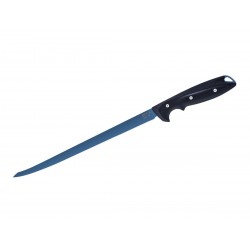-
Outdoor knives
-
Search for outdoor brands
- Aitor
- Al Mar
- ANV Knives
- Art Gladius
- Benchmade
- Black Fox
- Buck Knives
- Caliber
- Camillus
- Cold Steel
- Condor
- CRKT
- Fox Knives
- Harley Davidson
- Helle
- Herbertz
- Hydra Knives
- Hultafors
- Ibberson
- Fred Perrin
- Gerber
- Lione Wolf
- Ka Bar
- Kershaw
- Kizer
- Linton
- Marttiini
- Max Knives
- Mcusta
- Muela
- Morakniv
- Old Timer
- Ontario
- Opinel
- Outdoor EDGE
- Prezioso
- Puma Tec
- Ruger
- QSP Knives
- Santa Fe Stoneworks
- Schrade
- Smith & Wesson
- SOG Knives
- Spartan Blades
- Spyderco
- Swiza
- True Utility
- United cutlery
- UZI
- Witharmour
- Zero Tolerance
- Military Knives
- Survival knives
- Hunting knives
- Boat knives
- Fishing knives
- Diving knives
- Machete
- Knives Collection
- Damascus knives
- Vintage knives
- Swiss Army Knives
-
Search for outdoor brands
-
Kitchen knives
-
Brands kitchen knives
- Akinod
- Camel
- F. Dick
- Fischer Bargoin
- Güde
- ICEL
- Morakniv
-
Samura
- Samura Harakiri
- Samura Mo-V
- Samura Kaiju
- Samura 67
- Samura Damascus 67
- Samura Sakai
- Samura Shadow
- Samura Golf
- Samura blacksmith
- Samura Super 5
- Samura Okinawa
- Samura Damascus
- Samura Meteora
- Samura Bamboo
- Samura Inca
- Samura Mo-V Stonewash
- Samura Pro-S
- Samura Mad Bull
- Samura Reptile
- Samura STARK
- Samura Artefact
- Samura PRO-S Lunar
- Samura Butcher
- Spyderco
- Swibo
- Petromax Knives
- Opinel
- Tsubazo
- Xin Cutlery
- Chef's knives
- Kitchen knives for children
- Japanese Knives
- Damascus kitchen knives
- Professional knives
- Steak knives
- Kitchen knife set
- Table cutlery
- Chef's knife bag
- Ceppo coltelli
-
Brands kitchen knives
-
Outdoor supplies
-
Outdoor accessories brands
- Benchmade Tools
- Bobster
- Feuerhand
- Gerber Multi Tools
- Lansky
- Maxpedition
- Nebo Tools flashlights
- Nextool
- Nextorch
- Nite Ize
- Nordic Pocket Saw
- Petromax
-
Stanley
- Stanley Artisan
- Stanley Classic Legendary Bottle
- Stanley, Classic Legendary Camp Mug
- Stanley Classic Legendary Food Jar
- Stanley Classic Flask
- Stanley Classic Trigger-Action Travel Mug
- Stanley Go Quick Flip
- Stanley Go Everyday Tumbler
- Stanley Travel Mug
- Stanley To-Go
- Stanley Transit MUG
- Stanley GO Iceflow
- Silky
- Smith & Wesson Watches
- Multi-tool SOG
- Takeya
- True Utility - Multi Tool
- Work Sharp
- Konus
- Knife sharpener
- Car starter
- Barbecue Grill
- Thermal bottles
- Brazier
- Pocket flask
- Camping Fridge
- Cooling Box
- Outdoor lanterns
- Key Tool
- Multi tools
- Ballistic goggles
- Tactical Goggles
- Military watches
- Tactical pens
- Camping Cookware Set
- Power Bank
- Power Station
- Hand saws
- LED Flashlight
- Thermos
- Military Optics
- Military Backpacks
-
Outdoor accessories brands
-
Smoking Accessories
-
Brands smoking items
- Barling
- Boveda
- Cigar Caddy
- Palio
- Quality Importers
-
Rattray's
- Serie pipe Rattray's black sheep
- Serie pipe Pipa Rattray's The Angel's Share
- Pipe Rattray's Darke Ale
- Pipe Rattray's Six Friends
- Pipe Rattray's The Druids
- Pipe Rattray's Goblin
- Pipe Rattray's Starter Kit Joy
- Pipe Rattray's Blower's Daughter
- Pipe Rattray's Icebreaker Cobra te
- Pipe Rattray's Watchtower
- Pipe Rattray's Dark Reign
- Pipe Rattray's Nimbus burgundy
- Pipe Rattray's Misfit
- Pipe Rattray's Poty
- Pipe Rattray's The Fair Maid
- Pipe Rattray's Outlaw
- Pipe Rattray's Devil's Cut
- Pipe Rattray's Carnyx
- Pipe Rattray's Distillery
- Pipe Rattray's Brave heart
- Pipe Rattray's The Good Deal
- Pipe Rattray's LTD
- Pipe Rattray's Emblem
- Pipe Rattray's Samhain
- Pipe Rattray's Sanctuary
- Rattray's AHOY
- Rattray's Newcastle
- Rattray's Rannoch
- Jemar
- Xikar
- Les Fines Lames
- Dissim
- Mestango
- White Elephant
- Siglo
- Vector
- Cigar Lighter
- Pipe lighter
- Pipe Knife
- Pipe Tool
- Humidors
- Electric humidor
- Tobacco holder
- Cigar holder
- Smoking Pipes
- Cigar ashtray
- Smoking pipe holder
- Cigar cutter
-
Brands smoking items
-
Gardening Tools
- Novità
-
Outdoor knives
-
Kitchen knives
-
Outdoor supplies
-
-
Gardening
-
Outdoor Brands
-
Kitchen Brands
-
Brands for smokers
-
Outdoor knives
-
Kitchen knives
-
Outdoor supplies
-
Smoking Accessories
-
Gardening
- New products NEW
- Promotional products
-
Outdoor Brands
- Kitchen Brands
- Brands for smokers

Filter By
Price
Price
Handle Material
Handle Material
Fishing knives
Fishing Knives: Essential Tools for Every Angler
When it comes to fishing, the right gear is essential for a satisfying and safe experience. Among the tools that every fishing enthusiast should have in their tackle box, the fishing knife is one of the most versatile and useful accessories. Whether it's for filleting a catch, cutting lines, or performing other tasks.
Index:
What is a Fishing Knife?
A fishing knife is a tool specifically designed to assist anglers in activities related to catching and handling fish. Unlike other knives, fishing knives are built to handle marine or freshwater environments, where corrosion resistance and ease of handling are essential. A good fishing knife must be robust, easy to sharpen, and most importantly, safe to use even in high humidity and when immersed in water.
Fishing knives are used for various purposes: they can be employed for cutting lines, filleting fish, disinfecting or removing entrails, and even for emergency tasks like cutting nets or ropes. Their design varies based on different needs, and the size and type of blade can be chosen based on the type of fishing practiced and the fish being targeted.
Types of Fishing Knives
There are several types of fishing knives, each suited to specific needs. Each type of knife has characteristics that make it better suited for particular tasks or conditions. The main variants include:
Fixed Blade Knife
The fixed blade knife is one of the most commonly used tools by experienced anglers. Characterized by a solid blade that does not fold, it offers greater strength and durability. This type of knife is ideal for heavier tasks, such as filleting fish or handling larger catches. The fixed blade also offers greater safety, as there is no risk of it folding accidentally during use. A fixed blade knife, due to its robustness, is an excellent choice for fishing in marine environments.
Folding Knife
Folding knives are more compact and easier to carry due to their ability to fold in on themselves. This type of knife is perfect for those looking for a portable tool without sacrificing functionality. Despite the folding blade, many models are equipped with locking mechanisms to prevent the blade from closing accidentally during use. They are particularly appreciated by anglers who engage in light fishing activities or those who need a knife for quick, less demanding tasks.
Multi-tool Knife
Multi-tool knives combine several functions into one tool. In addition to the main blade, they may include pliers, bottle openers, line cutters, and other useful tools. This versatility makes them ideal for anglers who practice different types of fishing and want a single tool to perform various functions. Multi-tool knives are perfect for those seeking a comprehensive and compact solution.
Blade Materials
The material of the blade is a crucial factor in choosing a fishing knife, as it affects both durability and cutting ability. The main materials used in making fishing knife blades include:
Stainless Steel
Stainless steel is one of the most common materials for fishing knife blades due to its resistance to corrosion. This makes it particularly suitable for use in marine environments, where humidity and contact with saltwater can quickly damage other types of metals. Stainless steel is fairly durable and offers good sharpening capabilities, but it may be less resistant in conditions of intensive use.
Carbon Steel
Carbon steel is known for its ability to maintain a sharp edge longer than stainless steel. However, it is more prone to rust if not properly treated. For fishing knives made of carbon steel, it's crucial to take care of the blade and dry it thoroughly after use to prevent moisture damage. Despite this drawback, carbon steel is valued for its cutting performance and durability.
Titanium
Titanium is a lightweight and durable material that offers excellent resistance to corrosion. Although it is not as sharp as stainless steel or carbon steel, titanium is a popular choice for fishing knives used in particularly humid environments, such as saltwater fishing. Its durability is a significant advantage, and titanium knives require less maintenance than other types of materials.
Blade Length and Design
The length of the blade is an aspect that depends on individual preferences and the type of fishing. Fishing knives can have blades ranging from a few centimeters to over 20 cm. Shorter blades are generally preferred for quick tasks, such as cutting small lines or filleting smaller fish, while longer blades are ideal for activities that require more power and precision, such as cutting larger fish or handling nets.
In addition to the length, the design of the blade is another important aspect. Some fishing knives come with straight blades, while others have serrated edges. Serrated blades are particularly useful for cutting thick lines or resistant ropes, while straight blades are ideal for filleting and other precision tasks.
Handles and Safety
Safety is a key factor when it comes to fishing knives. A well-designed handle is essential to avoid slipping during use, especially in humid conditions or when immersed in water. The handles of fishing knives can be made from various materials, including plastic, rubber, wood, and composite materials. Rubber or non-slip handles are the most appreciated, as they provide a firm and comfortable grip even in wet conditions.
Additionally, some fishing knives come equipped with locking systems for the blade, which prevent it from accidentally folding during use, thus enhancing safety. Many models also feature a lanyard or cord to prevent the knife from falling into the water during use.
Maintenance and Care of the Fishing Knife
Proper maintenance of a fishing knife is essential for ensuring its longevity. After each use, it is advisable to wash the knife with fresh water to remove any salt or sand residue, which could corrode the blade. Additionally, it's important to dry the blade thoroughly to prevent rust formation, especially on carbon steel models.
To keep the knife sharp, it's necessary to regularly use a sharpening stone or sharpener. A well-sharpened knife not only facilitates fishing tasks but is also safer to use, as it requires less force to cut. Furthermore, proper storage of the knife is important: many anglers choose to store the knife in a protective sheath to avoid damage or breakage.
Conclusions
The fishing knife is an indispensable tool for every fishing enthusiast. With a wide range of models and features available, it's important to choose the right knife based on individual needs. Whether it's a fixed blade, folding, or multi-tool knife, each type of knife has its purpose and practical applications. Considering materials, blade length, safety, and maintenance are key factors in making the best choice. With the right knife, every angler can face the challenges of fishing with greater safety, efficiency, and comfort.
▷ Read More
Read less
There is 1 product.
Active filters
- Handle Material: GFN











































